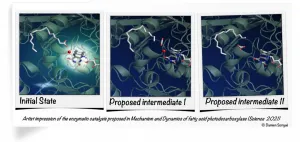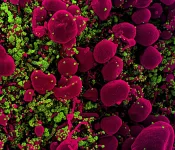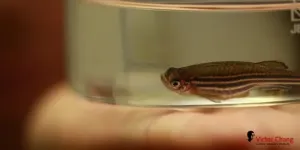INFORMATION:
Early humans evolved modern human-like brain organization after first African dispersal
2021-04-08
(Press-News.org) Modern human-like brains evolved comparatively late in the genus Homo and long after the earliest humans first dispersed from Africa, according to a new study. By analyzing the impressions left behind by the ancient brains that once sat inside now fossilized skulls, the authors discovered that the brains of the earliest Homo retained a primitive, great ape-like organization of the frontal lobe. The findings challenge the long-standing assumption that human-like brain organization is a hallmark of early Homo and suggest that the evolutionary history of the human brain is more complex than previously thought. Our modern brains are larger and structurally different than those of our closest living relatives, the great apes, particularly in frontal lobe areas involved with complex cognitive tasks like toolmaking and language. However, when these key differences arose during human evolution remains poorly understood. One of the major challenges in tracking brain evolution in early hominid species is that brain tissues rarely fossilize. As a result, much of what is known is derived from shape and structures on the surface of the brain cases of rare, fossilized skulls. Representations of these surfaces - or endocasts - can reveal patterned imprints representing the folds and indentations of the brain and its surrounding vasculature. Using a collection of well-preserved fossil Homo crania from the Dmanisi site in the modern-day nation of Georgia and a comparative sample of others from Africa and Southeast Asia, Marcia Ponce De León and colleagues tracked key changes in brain organization of early Homo from roughly 1.8 million years ago (Ma). They found that the structural innovations in the cerebral regions thought to allow for many of humans' unique behaviors and abilities emerged later in the evolution of Homo. According to Ponce De León et al., the findings suggest that modern human-like brain reorganization - which was probably in place by 1.7-1.5 Ma - was neither a requisite trait for genus Homo, nor a prerequisite for early Homo's dispersals into Europe and Asia. In a related Perspective, Amélie Beaudet discusses the study in greater detail.
ELSE PRESS RELEASES FROM THIS DATE:
Injection molding transparent glass like a plastic
2021-04-08
Researchers present a new, low-temperature method for injection-molding transparent fused silica glass, similar to how many plastic objects are manufactured. According to the authors, the process offers the possibility of producing complex and high-quality glass components using the same fabrication methods that allowed polymers to become one of the most important materials of the 21st century. The optical, thermal, mechanical and chemical properties of silicate glasses make them an ideal non-carbon based, high-performance material with applications ranging from packaging and architecture to high-throughput fiber optic ...
IntMEMOIR traces cell lineage though development and within native tissues
2021-04-08
Using a novel genetic editing system termed intMEMOIR, researchers reveal the cell lineage histories of individual cells within their native tissue context, according to a new study. The new approach provides a powerful new tool for recording cell lineage in diverse cellular systems. During multicellular development, a cell's spatial position and lineage play important roles in cell fate determination. The ability to visualize lineage relationships directly within their native tissues can provide valuable insight into the factors that affect development and disease. This promise has spurred the development of several ...
Enhanced X-Ray emissions coincide with giant radio pulses from crab pulsar
2021-04-08
X-ray emissions from the Crab Pulsar are more intense during giant radio pulses (GRPs), researchers report. The new findings provide constraints on the mechanisms underlying GRPs and may provide insights into other transient radio phenomena observed throughout the Universe. Pulsars, or rapidly spinning neutron stars, emit pulses of electromagnetic radiation from their magnetospheres and are observed from Earth as regular sequences of radio pulses. Most radio pulses from these distant objects are of a consistent intensity. Occasionally, however, sporadic and short-lived ...
Green chemistry and biofuel: the mechanism of a key photoenzyme decrypted
2021-04-08
The functioning of the enzyme FAP, useful for producing biofuels and for green chemistry, has been decrypted. This result mobilized an international team of scientists, including many French researchers from the CEA, CNRS, Inserm, École Polytechnique, the universities of Grenoble Alpes, Paris-Saclay and Aix Marseille, as well as the European Synchrotron (ESRF) and synchrotron SOLEIL. The study is published in Science on April 09, 2021.
The researchers decrypted the operating mechanisms of FAP (Fatty Acid Photodecarboxylase), which is naturally present in microscopic algae such as Chlorella. The enzyme had been identified in 2017 as able to use light energy to form hydrocarbons from fatty acids ...
Two studies support key role for immune system in shaping SARS-CoV-2 evolution
2021-04-08
Two studies published in the open-access journal PLOS Pathogens provide new evidence supporting an important role for the immune system in shaping the evolution of SARS-CoV-2, the virus that causes COVID-19. These findings--and the novel technology behind them--improve understanding of how new SARS-CoV-2 strains arise, which could help guide treatment and vaccination efforts.
For the first study, Rachel Eguia of Fred Hutchinson Cancer Research Center in Seattle, Washington, and colleagues sought to better understand SARS-CoV-2 by investigating a closely related virus that has circulated widely for a far longer period of time: the common-cold virus ...
Giant radio pulses from pulsars are hundreds of times more energetic than previously believed
2021-04-08
A group led by scientists from the RIKEN Cluster for Pioneering Research, using coordinated observations of the Crab pulsar in a number of frequencies, have discovered that the "giant radio pulses" which it emits include an increase in x-ray emissions in addition to the radio and visible light emissions that had been previously observed. This finding, published in Science, implies that these pulses are hundreds of times more energetic than previously believed and could provide insights into the mysterious phenomenon of "fast radio bursts (FRBs)."
Giant radio pulses--a phenomenon where extremely short, millisecond-duration pulses of radio waves are emitted--have ...
Blocking a protein could help overcome cancer resistance to PARP inhibitors
2021-04-08
Researchers at the Francis Crick Institute have found that blocking a specific protein could increase tumour sensitivity to treatment with PARP inhibitors. Their work published in Science , suggests combining treatments could lead to improved therapy for patients with inheritable breast cancers.
Some cancers, including certain breast, ovarian and prostate tumours, are caused by a fault in the BRCA1 or BRCA2 genes, which are important for DNA repair. Treatment for these cancers has greatly improved thanks to the discovery of PARP inhibitors, drugs which capitalise on this weakness in the cancer ...
New discovery uncovers secret switch that could revolutionise heart attack treatment
2021-04-08
Scientists at the Victor Chang Cardiac Research Institute in Sydney have discovered a critical new gene that it is hoped could help human hearts repair damaged heart muscle after a heart attack.
Researchers have identified a genetic switch in zebrafish that turns on cells allowing them to divide and multiply after a heart attack, resulting in the complete regeneration and healing of damaged heart muscle in these fish.
It's already known that zebrafish can heal their own hearts, but how they performed this incredible feat remained unknown, until now. In research recently published in the prestigious journal, Science, the team at the Institute drilled down into a critical ...
Modern human brain originated in Africa around 1.7 million years ago
2021-04-08
Modern humans are fundamentally different from our closest living relatives, the great apes: We live on the ground, walk on two legs and have much larger brains. The first populations of the genus Homo emerged in Africa about 2.5 million years ago. They already walked upright, but their brains were only about half the size of today's humans. These earliest Homo populations in Africa had primitive ape-like brains - just like their extinct ancestors, the australopithecines. So when and where did the typical human brain evolve?
CT comparisons of skulls reveal modern brain structures
An international ...
Novel algorithm reveals birdsong features that may be key for courtship
2021-04-08
Researchers have developed a new algorithm capable of identifying features of male zebra finch songs that may underlie the distinction between a short phrase sung during courtship, and the same phrase sung in a non-courtship context. Sarah Woolley of McGill University in Montreal, Canada, and colleagues present these findings in the open-access journal PLOS Computational Biology.
Like many animals, male zebra finches adjust their vocal signals for their audience. They may sing the same sequence of syllables during courtship interactions with females as ...



